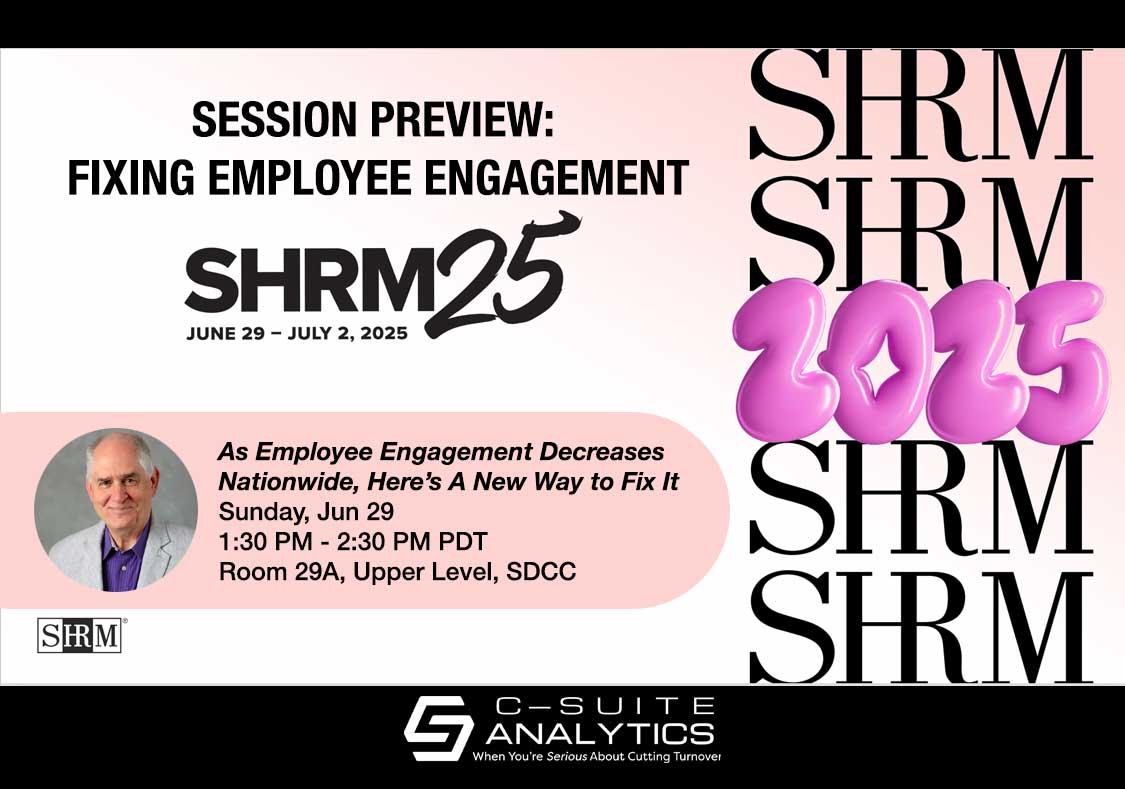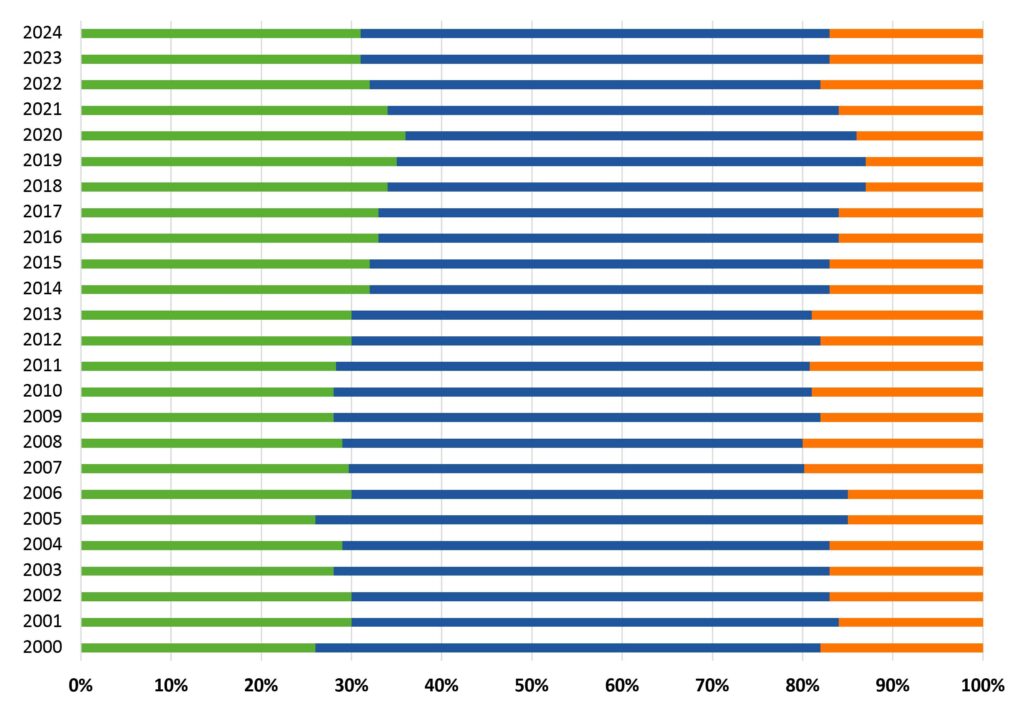AI, deportations, tariffs, and birthrate declines are reshaping America's workforce—blue- and white-collar alike. From baby boomer exits to AI disruptions, breaking down the workforce challenges no leader can afford to ignore.
SHRM25 Session Preview: Fixing Employee Engagement

To be blunt, employee engagement is a mess. Gallup says global disengagement costs $8.8 trillion annually which sounds both immeasurable and inconceivable.[i] Another report says U.S. companies spend $450 to $500 billion per year to measure and fix it.[ii] Yet another says a full 80% of companies are conducting these surveys.[iii] But Gallup also tells us that U.S. engagement has never improved since they started measuring it twenty-five years ago, and worse, it’s getting worse.
The above paragraph sounds like I made it up, but every detail is true. And if you’re heading for the SHRM Annual Conference later this month in San Diego, I’ll be speaking on how to fix it on Sunday, June 29th, at 1:30 PM.
First, Engagement Has Never, Ever Gotten Better
Gallup has reported on U.S. companies’ employee engagement every year since 2000. We at C-Suite Analytics track their reporting each year and update the below chart. Here are the results so far:

Gallup reports engagement in three categories: the green on the left indicates the percentage of U.S. workers who are engaged, the blue in the middle indicates the percentage who are not engaged, and the orange on the right indicates the percentage who are in Gallup’s terms “actively disengaged”. This latter group undermines the work of the others.
The obvious first conclusion is that U.S. employee engagement has been steady throughout, regardless of changes in our economy, war vs peace, or any other societal trend. So I would conclude secondly that engagement is based on what is happening inside our buildings versus outside in our society.
Second, Engagement Is Getting Worse, No Matter How Much $ We Through At It
The above chart says so, as does a recent Gallup report headline: U.S. Employee Engagement Sinks to 10-Year Low. So the logical question becomes now that we have done these surveys for so many years and we should be getting really good at this, plus we seem to have unlimited money to fix engagement, how can we be failing by such an incredibly high margin?
The easy out is to blame workers, and especially young ones. Baby-boomers are moving on, young workers don’t bring the grit, helicopter parents have been far too easy on their kids, blah blah blah.
Third, Here Are the Reported Reasons Why
There have been many published opinions for this failure of course. In the same report noted just above, Gallup pointed their finger toward clarifying job expectations and ensuring “someone” cares about them as a person and encourages their development. Gallup’s ultimate conclusions are for leaders to (1) define what they want in their workplace culture, (2) lead with their own strengths while clarifying the organization’s purpose, and (3) prioritize identifying and selecting managers with the innate ability to engage and inspire employees. In another Gallup report on employee detachment, Gallup says employees are disconnected from their employers due to rapid organizational change/hybrid & remote growing pains/new customer expectations/new employer expectations/broken performance management systems.[iv]
Here’s A Better, Winning Idea
The above paragraph is full of broad strategies without proven tactics, but in fairness it’s because Gallup’s business intent is for us to click on these reports to learn more. Nonetheless, every phrase in that paragraph stands in stark contrast to another, much more usable Gallup report that says this, from a book authored by their CEO:
Of all the codes Gallup has been asked to crack dating back to 80 years to our founder, George Gallup, the single most profound, distinct, and clarifying finding –ever—is probably this one: 70% of the variance in team engagement is determined solely by the manager.[v]
Wow. This triggers the main point of my report here, that not just Gallup but every engagement survey vendor points to broad strategies that inevitably lead to one-size-fits-all programs, that completely overlook and result in zero engagement responsibilities for first-line managers.
Gallup speaks of high-level organizational development terms like culture, purpose, organizational change, and employee detachment…and they almost, almost name first-line leaders when they say that someone cares about employees and encourages their development. Yet the common company employee engagement survey response goes like this:
- Conduct the survey.
- Wait a month for the results.
- HR reports major trends to the executive team.
- Improvement plans are developed, usually by HR and by each manager.
- The manager plans are never scrutinized for quality and more importantly managers are not held accountable for implementing their plans.
- HR often times gathers an employee committee to develop items with the lowest scores.
- And then the CEO sends an email to employees reporting all that will be done to improve the next round of scores.
And one-size-fits-all programs prevail. Want to improve recognition? Employee-of-the-month plus backpacks for ten years of service and clocks for twenty. Communication? CEO videos, town hall meetings, and more info uploaded on the company intranet. Benefits? Let’s add pet insurance.
What Employees Really Want
They want a manager they can trust. From their start, employee engagement solutions have been trains off the track. Arrows that miss the target. Baseball teams that have everything but pitching and hitting. When employees are having dinner and respond to “How was your day, dear?”, no one says their day was OK but they wish they had pet insurance. They talk about their boss, their colleagues, and their duties…and their direct supervisor has by far the most influence on all three.
So The Best, Fresh-Thinking Solution Is…
…hold managers accountable for their own engagement survey scores. And teach your managers to conduct Stay Interviews with each employee so they know precisely what that employee needs to become engaged, to stay, and to become happy with their work.
This is what I’ll talk about at the SHRM Annual Conference in San Diego on Sunday, June 29th, at 1:30 PM PDT. Much more detail is available in my upcoming book, Targeting Turnover: Make Managers Accountable, Win the Workforce Crisis, which will be available in September. I welcome your questions and feedback at dfinnegan@c-suiteanalytics.com
[i] https://www.gallup.com/workplace/393497/world-trillion-workplace-problem.aspx
[ii] https://blog.haiilo.com/blog/employee-engagement-8-statistics-you-need-to-know/
[iii] https://decisionwise.com/resources/articles/truth-employee-engagement-measurement-practices/#:~:text=Most%20Companies%20Measure%20Employee%20Engagement%20Every%20Year&text=45%20percent%20of%20companies%20reported,and%2014%20percent%20measure%20sporadically.
[iv] https://www.gallup.com/workplace/653711/great-detachment-why-employees-feel-stuck.aspx
[v] It’s The Manager by Jim Clifton and Jim Harter, Gallup Press, 2019, page 12.



